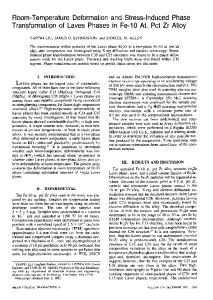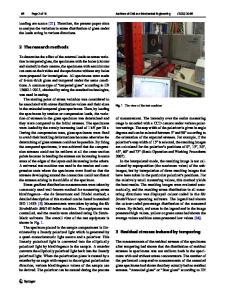Room temperature stress relaxation in nanocrystalline Ni measured by micropillar compression and miniature tension
- PDF / 1,021,189 Bytes
- 11 Pages / 584.957 x 782.986 pts Page_size
- 80 Downloads / 244 Views
Brad L. Boyce Sandia National Laboratories, Materials Science and Engineering Center, Albuquerque, New Mexico 87185, USA
Aidan Taylor, Madoka Hasegawa, Laetitia Philippe, and Johann Michler Empa, Swiss Federal Laboratories for Materials Science and Technology, Laboratory for Mechanics of Materials and Nanostructures, CH-3602 Thun, Switzerland (Received 6 October 2015; accepted 29 February 2016)
In this study, we report a micropillar stress relaxation technique employing a stable displacementcontrolled, in-situ scanning electron microscope indenter, and unusually large micropillars to precisely measure stress relaxation in electroplated nanocrystalline Ni thin films. The observed stress relaxation is significant under constant displacement: even well below the 0.2% offset yield strength, the stresses relax by ;4% within a minute; in the work hardening regime, stress relaxes by ;9% in 1 min. A logarithmic fit of the relaxation curves is consistent with an Arrhenius thermal activation of plasticity and suggests an activation volume in the vicinity of ;10 b3. The apparent and effective activation volumes diverge at lower strains, particularly in the “elastic” regime. These measurements are compared to similar measurements performed on free-standing thin film tensile coupons. Both methods yield similar results, thereby validating the applicability of pillar compression to capture time-dependent plasticity. To our knowledge, these are the first micropillar stress relaxation experiments on metals ever reported.
I. INTRODUCTION
Plastic deformation in nanocrystalline metals is known to be strongly time-dependent. This viscoplasticity manifests itself as a high degree of strain rate sensitivity (SRS) and susceptibility to creep and stress relaxation even at room temperature. Numerous studies have reported on creep behavior1–5 and SRS6–10 of nanocrystalline materials using conventional tensile or compression tests on bulk specimens. Stress relaxation properties, on the other hand, have not received as much attention, with very few studies9,11,12 reported. Timedependent deformation is an important criterion for designing microcomponents made up of nanocrystalline materials. Both creep and stress relaxation contribute, in a convoluted manner, toward the failure of nanocrystalline metal microcomponents when placed under contact stresses. Typically, time-dependent deformation like creep, stress relaxation, and SRS are measured at constant stress, strain or strain rate conditions, respectively, on multiple samples, and often at various temperatures. Contributing Editor: George M. Pharr a) Address all correspondence to this author. e-mail: [email protected] DOI: 10.1557/jmr.2016.101 J. Mater. Res., Vol. 31, No. 8, Apr 28, 2016
http://journals.cambridge.org
Downloaded: 26 Jun 2016
The extracted activation parameters from these measurements are referred to as “apparent” activation parameters (apparent activation energy, apparent activation volume). They are termed as “apparent” parameters because the microstructure, comprising
Data Loading...










